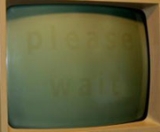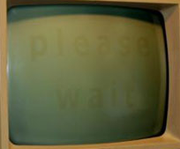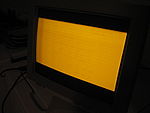
Phosphor burn-in
Encyclopedia

Cathode ray tube
The cathode ray tube is a vacuum tube containing an electron gun and a fluorescent screen used to view images. It has a means to accelerate and deflect the electron beam onto the fluorescent screen to create the images. The image may represent electrical waveforms , pictures , radar targets and...
(CRT) display or computer display
Computer display
A monitor or display is an electronic visual display for computers. The monitor comprises the display device, circuitry, and an enclosure...
monitor or Television set
Television set
A television set is a device that combines a tuner, display, and speakers for the purpose of viewing television. Television sets became a popular consumer product after the Second World War, using vacuum tubes and cathode ray tube displays...
caused by cumulative non-uniform usage of the pixels.
Causes of screen burn
With phosphor-based electronic displays (for example CRT-type computer monitors or plasma displayPlasma display
A plasma display panel is a type of flat panel display common to large TV displays or larger. They are called "plasma" displays because the technology utilizes small cells containing electrically charged ionized gases, or what are in essence chambers more commonly known as fluorescent...
s), non-uniform use of pixels, such as prolonged display of non-moving images (text or graphics), gaming, or certain broadcasts with tickers and flags, can create a permanent ghost-like image of these objects or otherwise degrade image quality. This is because the phosphor compounds which emit light to produce images lose their luminance
Luminance
Luminance is a photometric measure of the luminous intensity per unit area of light travelling in a given direction. It describes the amount of light that passes through or is emitted from a particular area, and falls within a given solid angle. The SI unit for luminance is candela per square...
with use. Uneven usage results in uneven light output over time, and in severe cases can create a ghost image of previous content. Even if ghost images are not recognizable, the effects of screen burn are an immediate and continual degradation of image quality.
The length of time required for noticeable screen burn to develop varies due to many factors, ranging from the quality of the phosphors employed, to the degree of non-uniformity of sub-pixel usage. It can take as little as only a few weeks for noticeable ghosting to set in, especially if the screen displays a certain image (example: a menu bar at the top or bottom of the screen) constantly, and displays it continually over time. In the rare case when horizontal or vertical deflection circuits fail, all output energy is concentrated to a vertical or horizontal line on the display which causes almost instant screen burn.
CRT

Phosphor burn-in is particularly prevalent with monochromatic CRT screens, such as the amber or green monochrome monitors common on older computer systems and dumb terminal stations. This is partly because those screens displayed mostly non-moving images, and at one intensity: fully on. Yellow screens are more susceptible than either green or white screens because the yellow phosphor is less efficient and thus requires a higher beam current. Color screens, by contrast, use three separate phosphors (red, green, and blue) per pixel (called "sub-pixels"), mixed in varying intensities to achieve specific colors, and in typical usage patterns such as "traditional" TV viewing (non-gaming, non-converged TV usage, non-Internet browsing, broadcasts without tickers or flags) are used for operations where colors and on-screen object placement approach uniformity.
Modern CRT displays are less susceptible than older CRTs because they have a layer of aluminum behind the phosphor which offers some protection. The aluminum layer was provided to reflect more light from the phosphor towards the viewer. As a bonus, the aluminum layer also prevented ion burn of the phosphor and the ion trap, common to older monochrome CRT displays, was no longer required.
Plasma, LCD and OLED displays
Plasma displays are highly susceptible to burn-in, while LCD-type displays are generally less so. Because of the more rapid luminance degradation of current organic compounds used in OLED-type displays, OLED is even more susceptible to burn-in than plasma. In addition, the wide variation in luminance degradation with OLED will cause noticeable color drift over time (where one of the red-green-blue colors becomes more prominent).In the case of LCDs, the mechanics of burn-in are different than plasma and OLED, which develop burn-in from luminance degradation of the light-emitting pixels. For LCDs, burn-in develops in some cases because pixels permanently lose their ability to return to their relaxed state after a continued static usage profile. In more typical usage profiles this image persistence
Image persistence
Image persistence is the LCD and plasma display equivalent of screen burn. Unlike screen burn, however, the effects are usually temporary. Plasma displays can also suffer from burn-in.-Cause:...
in LCD is only transient. All major LCD manufacturers' warranties exclude coverage for burn-in (permanent image persistence) as a result.
Both plasma-type and LCD-type displays exhibit a similar phenomenon called transient image persistence, which is sometimes confused with screen burn but is not permanent. In the case of plasma-type displays transient image persistence is caused by charge build-up in the pixel cells (not cumulative luminance degradation as with burn-in), which can be seen sometimes when a bright image that was set against a dark background is replaced by a dark background only; this image retention is usually released once a typical-brightness image is displayed and does not inhibit the display's typical viewing image quality.
Prevention
ScreensaverScreensaver
A screensaver is a type of computer program initially designed to prevent phosphor burn-in on CRT and plasma computer monitors by blanking the screen or filling it with moving images or patterns when the computer is not in use...
s derive their name from their original purpose, which was an active method of attempting to stave off screen burn. By ensuring that no pixel or group of pixels was left displaying a static image for extended periods of time, phosphor luminosity was preserved. Modern screensavers can turn off the screen when not in use.
In many cases the use of a screensaver is impractical. Most plasma-type display manufacturers include methods for reducing the rate of burn-in by rotating the image slightly, which does not eliminate screen burn, but can soften the edges of any ghost image that does develop.
Elimination
It is sometimes possible to remedy screen burn-in through the use of remedial softwares and remedial devices. This displays random colors on every pixel of the panel to fix the burn-in, but in severe cases (like physical damage) this may not resolve the problem.Historical notes
The most prevalent burn-in image on early televisions was said to be that of the RCA Indian Head test cardIndian Head test card
The Indian Head Test Pattern was a black and white television test pattern which was introduced in 1939 by RCA of Harrison, New Jersey as a part of the RCA TK-1 Monoscope...
, which predates the use of the current SMPTE color bars
SMPTE color bars
The SMPTE color bars are a type of television test pattern, and is most commonly used in countries where the NTSC video standard is dominant, such as those in North America. The Society of Motion Picture and Television Engineers refers to this test pattern as Engineering Guideline EG 1-1990...
. This was due to the viewer leaving the TV set on at the end of the day, which was not recommended by the TV manufacturers.

